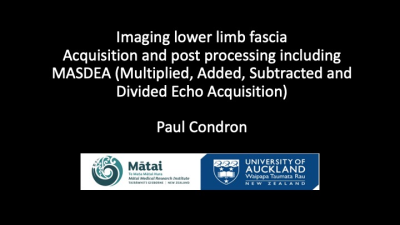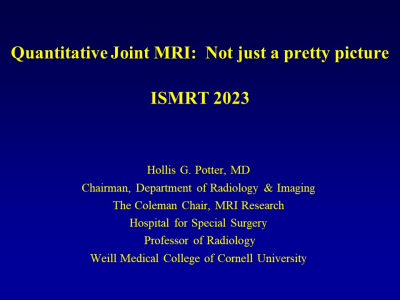ISMRT Education Session
MSK
ISMRM & ISMRT Annual Meeting & Exhibition • 03-08 June 2023 • Toronto, ON, Canada

| 13:45 |
MR Neurography of Peripheral Nerves
Ben Kennedy
Keywords: Neuro: Nerves, Musculoskeletal: Muscular, Image acquisition: Sequences Musculoskeletal nerve neuropathies, neuritis and palsies have often been diagnosed clinically and sent for MRI scans to investigate their appearance and if any other gross pathology abutting the nerves is a cause for the patient symptoms. For many years we have been able to visualize these nerves in their main branches, however the site of change can be extremely subtle in signal change and in most cases do not enhance after the administration of intravenous Gadolinium. Dedicated 3D Nerve sequences have changed diagnostic confidence in these cases and continued to evolve in sensitivity with improved sequence structure and parameters. |
|
| 14:15 |
 |
Imaging Fascia. Acquisition & Post Processing Including MASDEA
(Multiplied, Added, Subtracted & Divided Echo Acquisition)
paul condron
Keywords: Musculoskeletal: Tendons, Image acquisition: Sequences, Musculoskeletal: Skeletal The aim of this study was to provide high resolution and high contrast images of lower limb fascia. Both 3D radial ZTE and 3D cones dual echo (DE) UTE sequences identified and measured fascia in concurrence with current literature and autopsy measurements.We applied the theories of echo subtraction and division to amplify the contrast of short TE tissues (aponeuroses, fascia, ligaments) compared to longer TE tissues (fat and muscle). This method increased the contrast of fascia, addressed the issue of high fat signal, provided a T2* map of the lower limb and produced cortical bone images. |
| 14:45 |
 |
Quantitative MRI Joint Mapping
Hollis Potter
Keywords: Musculoskeletal: Joints The utility of quantitative MR in detecting early matrix depletion in tissues pertinent to musculoskeletal application will be discussed, including hyaline cartilage, fibrocartilage, ligament, muscle and tendon. The clinical application of both traditional and newer techniques, including ultrashort TE and zero echo time (ZTE) imaging will be discussed, including the use of in silico modelling and load bearing joint assessment. Various limitations of particular pulse sequences will be discussed, as well as the use of deep learning/denoising techniques to reduce scan acquisition time and facilitate image segmentation and analysis. |
The International Society for Magnetic Resonance in Medicine is accredited by the Accreditation Council for Continuing Medical Education to provide continuing medical education for physicians.